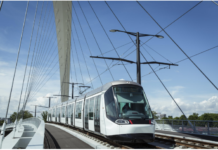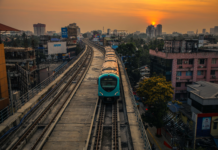Indian Railways will improve connection in the North East! With improved Indian Railways connectivity, the North East region of the country has received a significant infrastructure boost in recent years. According to the national transporter, the entire Indian Railways network in the country’s Northeastern states has been converted to a broad gauge network. Between 2014 and 2017, a total of 972 kilometers of track were converted to a broad gauge network. Except for the state of Sikkim, the Indian Railways network now connects all of the North East states.
In the coming years, the rail network is expected to connect even Sikkim. The railway network already connects the capitals of Tripura, Assam, and Arunachal Pradesh. Five major Indian Railways projects will provide a significant boost to the North-East in the coming years:
Jiribam-Imphal railway project: The state of Manipur’s capital, Imphal, will be connected to Indian Railways via the 111-kilometer-long Jiribam-Imphal project. This railway project is expected to be finished by March 2022.
Bhairabi Sairang railway project: The state of Mizoram’s capital, Aizawl, will be connected to Indian Railways via the 51-kilometer-long Bhairabi Sairang project, which is expected to be completed in March 2023.
Dimapur-Kohima railway project: The state of Nagaland’s capital, Kohima, will be connected to the rail network via the 82-kilometer-long Dimapur-Kohima railway project. This rail project is scheduled to be completed in March 2023.
Teteliya-Byrnihat railway project: Shillong, the state capital of Meghalaya, will be linked to the Indian Railways network via the 22-kilometer-long Teteliya-Byrnihat project. This railway project is expected to be finished by March 2022.
Manipur, Mizoram and Nagaland to get rail connectivity by 2023
The North-east Frontier Railways (NFR), which has already connected Assam’s main city Guwahati (adjacent capital Dispur), Tripura, and Arunachal Pradesh’s capital cities, is laying tracks to connect the capital cities of three more north-eastern states Manipur, Mizoram, and Nagaland by March 2023.
138 years ago, the first train in the north-east region chugged out of the industrial city of Dibrugarh in eastern Assam. Sanjive Roy, General Manager of NFR, stated that new railway lines were laid to extend the railway lines in three more capital cities of northeast India: Imphal (Manipur), Aizawl (Mizoram), and Kohima (Nagaland), excluding Shillong in Meghalaya and Gangtok in Sikkim.
“Work on the broad gauge railway line in Manipur, Mizoram, and Nagaland has been going well. Mr. Roy was quoted as saying, “There are some land-related and other environmental problems in Sikkim and Meghalaya, which are causing a delay in extending the railway networks in the two hilly states.”
According to the NFR General Manager, the government has approved the electrification of railway lines in the region, and tender-related work is currently underway. “Works on the 12.23-kilometer Agartala (Tripura)-Akhaura (Bangladesh) new railway lines are underway, and it will be completed by March next year,” he said.
The Agartala-Akhaura railway line would facilitate the transport of goods between the two countries and would greatly benefit India’s landlocked north-eastern states. The distance between Agartala and Kolkata via Bangladesh would be cut in half, from 1,613 km through mountainous terrain to 514 km.
The 12.23 km India-Bangladesh new railway line connected with the existing Agartala railway station, with 5.46 km railway tracks laid in India (on the outskirts of the capital city Agartala) and 6.57 km railway tracks laid in Bangladesh.
The Rs 972-crore project was finalised in January 2010 during Bangladesh Prime Minister Sheikh Hasina’s visit to New Delhi, when she met then-Indian Prime Minister Manmohan Singh.
The NFR spent Rs 1,150 crore to extend the railway lines up to two bordering sub-divisional towns — Sabroom and Belonia — both cities located along the Bangladesh border, facilitating connectivity with the neighbouring country’s railway networks.
Subhanan Chanda, Chief Public Relations Officer (CPRO) of the NFR, stated that while the NFR has made progress in most of the N-E states with rail connectivity, Sikkim remains off the Indian railway map.
“Work on providing rail connectivity for Sikkim was sanctioned in 2008-09. The proposed railway line would pass through the Mahananda wildlife sanctuary, causing a slew of environmental issues that stymied progress. This is a national project that is critical to the overall development of Sikkim. Apart from being strategically important, it is expected to boost connectivity of the landlocked state, which shares its border with three neighbouring countries — China, Nepal, and Bhutan — once completed,” Chanda said.
According to the CPRO, 41.55 kilometres of the 44.96-kilometer stretch are in West Bengal and 3.41 kilometres are in Sikkim. The entire section is being built with cutting-edge technology to allow trains to travel at speeds of up to 100 kilometres per hour. The estimated project cost is nearly Rs 8,900 crore, of which nearly Rs 335.52 crore has already been spent through July 2020.
Indian Railways plan to connect all state capitals in northeast
Indian Railways plans to connect all state capitals in the north-eastern region as part of the central government’s policy for comprehensive development of the entire NE region. The Bairabi – Sairang project has already been allocated around 1,000 crore, and it is being carried out by Mizoram’s Northeast Frontier Railway (NFR). Along the new line from Bhairabi, there will be four stations: Hortoki, Kawnpui, Mualkhang, and Sairang. Railway has set a completion date of 2023 for the project. The total length of the project is 51.38 kilometres, with a total investment of 5521.45 crore. The project will include 55 major and 87 minor bridges, as well as 5 Road over Bridges (ROBs) and 6 Road under Bridges (RUBs). The overall project will also include the construction of several tunnels, and the completion of all of the region’s proposed rail connectivity projects will result in the transformation of the northeast through improved transportation facilities.
Conclusion
Better rail connectivity will benefit not only the local population but also the entire Northeast region’s economy. State traders will be able to bring items of daily consumption as well as construction materials in a much cheaper, cost-effective, and environmentally friendly manner. Similarly, farmers will be able to send their products to a larger market in each state at a lower cost and in a timely manner.






Very encouraging